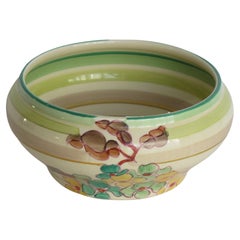Clarice Cliff Hydrangea
Mid-20th Century English Art Deco Decorative Bowls
Earthenware
People Also Browsed
Antique 1870s Japanese Meiji Cabinets
Elm
Vintage 1970s French Mid-Century Modern Coffee and Cocktail Tables
Sandstone
Vintage 1970s Belgian Brutalist Doors and Gates
Aluminum
Vintage 1970s Italian Mid-Century Modern Ceramics
Ceramic
Antique Early 1900s Austrian Art Nouveau Vases
Earthenware
Antique 19th Century English Gothic Revival Beds and Bed Frames
Walnut
Antique 19th Century Chinese Chinoiserie Lacquer
Marble
21st Century and Contemporary Italian Art Deco Screens and Room Dividers
Beech
Vintage 1930s French Art Deco Vanities
Aluminum, Copper, Wrought Iron
Vintage 1970s Italian Mid-Century Modern Coffee and Cocktail Tables
Glass, Wood
Late 20th Century American Modern Coffee and Cocktail Tables
Chrome
21st Century and Contemporary Indian Indian Rugs
Wool, Silk
Antique Early 1900s French Art Nouveau Shelves and Wall Cabinets
Wood
21st Century and Contemporary Indian Table Lamps
Brass, Nickel
Early 20th Century English Arts and Crafts Fireplaces and Mantels
Copper
20th Century Unknown Egyptian Revival Wall-mounted Sculptures
Ceramic
A Close Look at Art-deco Furniture
Art Deco furniture is characterized by its celebration of modern life. More than its emphasis on natural wood grains and focus on traditional craftsmanship, vintage Art Deco dining chairs, tables, desks, cabinets and other furniture — which typically refers to pieces produced during the 1920s and 1930s — is an ode to the glamour of the “Roaring Twenties.”
ORIGINS OF ART DECO FURNITURE DESIGN
- Emerged in the 1920s
- Flourished while the popularity of Art Nouveau declined
- Term derives from 1925’s Exposition Internationale des Arts Décoratifs et Industriels Modernes (International Exhibition of Modern Decorative and Industrial Arts) in Paris, France
- Informed by Ancient Egypt, Cubism, Futurism, Louis XVI, De Stijl, modernism and the Vienna Secession; influenced Streamline Moderne and mid-century modernism
CHARACTERISTICS OF ART DECO FURNITURE DESIGN
- Bold geometric lines and forms, floral motifs
- Use of expensive materials such as shagreen or marble as well as exotic woods such as mahogany, ebony and zebra wood
- Metal accents, shimmering mirrored finishes
- Embellishments made from exotic animal hides, inlays of mother-of-pearl or ivory
ART DECO FURNITURE DESIGNERS TO KNOW
VINTAGE ART DECO FURNITURE ON 1STDIBS
Few design styles are as universally recognized and appreciated as Art Deco. The term alone conjures visions of the Roaring Twenties, Machine Age metropolises, vast ocean liners, sleek typography and Prohibition-era hedonism. The iconic movement made an indelible mark on all fields of design throughout the 1920s and ’30s, celebrating society’s growing industrialization with refined elegance and stunning craftsmanship.
Widely known designers associated with the Art Deco style include Émile-Jacques Ruhlmann, Eileen Gray, Maurice Dufrêne, Paul Follot and Jules Leleu.
The term Art Deco derives from the name of a large decorative arts exhibition held in Paris in 1925. “Art Deco design” is often used broadly, to describe the work of creators in associated or ancillary styles. This is particularly true of American Art Deco, which is also called Streamline Moderne or Machine Age design. (Streamline Moderne, sometimes known as Art Moderne, was a phenomenon largely of the 1930s, post–Art Nouveau.)
Art Deco textile designers employed dazzling floral motifs and vivid colors, and while Art Deco furniture makers respected the dark woods and modern metals with which they worked, they frequently incorporated decorative embellishments such as exotic animal hides as well as veneers in their seating, case pieces, living room sets and bedroom furniture.
From mother-of-pearl inlaid vitrines to chrome aviator chairs, bold and inventive works in the Art Deco style include chaise longues (also known as chaise lounges) and curved armchairs. Today, the style is still favored by interior designers looking to infuse a home with an air of luxury and sophistication.
The vintage Art Deco furniture for sale on 1stDibs includes dressers, coffee tables, decorative objects and more.
Finding the Right Decorative-bowls for You
Vintage, new and antique decorative bowls have been an important part of the home for centuries, although their uses have changed over the years. While functional examples of bowls date back thousands of years, ornamental design on bowls as well as baskets likewise has a rich heritage, from the carved bowls of the Maya to the plaited river-cane baskets of Indigenous people in the Southeast United States.
Decorative objects continue to bring character and art into a space. An outdoor gathering can become a sophisticated garden party with the addition of a few natural-fiber baskets to hold blankets or fruit on a table, as demonstrated in the interior design work by firms such as Alexander Design.
Elsewhere, Richard Haining’s reclaimed wood vases and bowls can express eco-consciousness. Sculptural handmade cast concrete bowls like those made by the Oakland, California–based UMÉ Studio introduce compelling textures to your dining room table.
Minimalist ceramic decorative bowls of varying colors can evoke a feeling of human connectedness through their association with handmade craftsmanship, such as in the rooms envisioned by South African interior designer Kelly Hoppen. And you can elevate any space with ceramic bowls that match the color scheme.
Browse the 1stDibs collection of decorative bowls and explore the endless options available.
- 1stDibs ExpertFebruary 21, 2024Clarice Cliff is famous for her Art Deco ceramics. The dazzling colors and bold geometric patterns of her pieces have become synonymous with the period. Cliff produced more than 100 works during her career and achieved commercial success during her lifetime. Some of her best-known ceramics include the Bizarre plate, the Crocus jug and the Inspiration Caprice plate. Explore a variety of Clarice Cliff ceramics on 1stDibs.
- 1stDibs ExpertApril 5, 2022No, Clarice Cliff pottery is no longer being made. In 1964 Cliff sold her factory and stopped designing. Throughout the following years there were a few different batches of her work reproduced, the first by Midwinter pottery who bought her factory. Later reproductions were done by Wedgewood, who owned the Clarice Cliff name at the time. On 1stDibs, find a collection of authentic Clarice Cliff pottery from some of the world’s top sellers.
